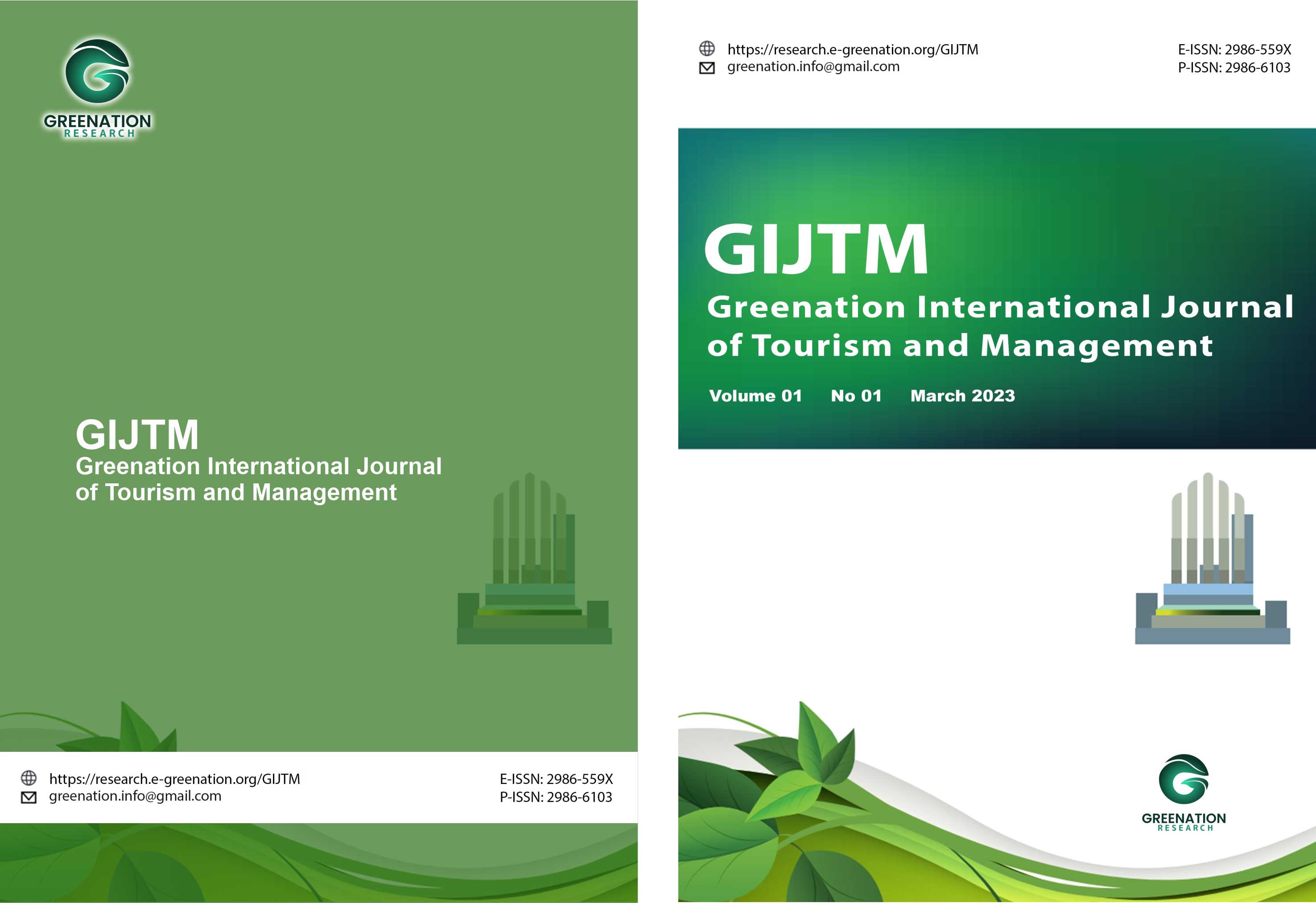The Influence of Organizational Culture on Employee Engagement: The Role of Organizational Commitment As An Intervening Variable
DOI:
https://doi.org/10.38035/gijtm.v1i2.46Keywords:
Organizational Culture, Employee Engagement, Organizational CommitmentAbstract
The purpose of this paper is to determine the influence of Organizational Culture on employee engagement with organizational commitment as an intervening variable. This research used a quantitative approach to reveal the relationship between research variables with Structural Equation Modeling (PLS-SEM) as a data analysis tool. The findings of this research are Organizational Culture has a positive and significant influence on employee engagement. Organizational commitment has a positive and significant influence on mediating Organizational Culture to employee engagement. This research provides a new perspective on Human Resource Management with KSPPS BMT UGT Nusantara as the research object.
References
Ahmad, AFN, Haerani, S., Hamid, N., & Reni, A. (2019). The Influence of Organizational Culture, Organizational Commitment and Job Satisfaction on the Performance of High School Teachers in Makassar. Hasanuddin Journal of Applied Business and Entrepreneurship, 2(2), 90–99.
Ahmad, S., & Harahap, R. (2020). The Role of Baitul Mal Wa Tamwil (Bmt) in Developing the People's Economy. Human Falah, 7(1), 19–29.
Armstrong, M. (2012). Armstrong's Handbook of Reward Management Practice: Improving Performance Through Reward (6th ed.). Kogan Page Publishers.
Bakhri, MS (2015). The Success of Sharia Cooperatives in Sidogiri The Best Islamic Micro Finance. Create.
Bakhri, MS (2017). BMT UGT Rank 4 Indonesian Large Cooperatives 2017.
Chin, WW (1998). The partial least squares approach to structural equation modeling. In Marcoulides GA (Ed.). Modern Methods for Business Research, 295(2), 295–336.
Colquitt, JA, Lepine, JA, & Wesson, MJ (2009). Organizational Behavior. Colquitt, JA, LePine, JA, & Wesson, MJ (2015). Organizational behavior:
Improving performance and commitment in the workplace. In McGraw-Hill
Education.
Daft, RL (2008). Organization Theory and Design.
Dahlan, MS (2014). Statistics for Medicine and Health Descriptive, Bivariate and Multivariate. Equipped with an application using SPSS. 6th ed. Jatinagor: Alqaprint; 2014. In Salemba Medika.
Denison. (1993). What Is the Difference Between Organizational Culture and Organizational Climate? a Native'S Point of View on a Decade of Paradigm Wars. Academy of Management Proceedings, 1993(1), 207–211. https://doi.org/10.5465/ambpp.1993.10316760
Denison, Nieminen, L., & Kotrba, L. (2014). Diagnosing organizational cultures: A conceptual and empirical review of culture effectiveness surveys. European Journal of Work and Organizational Psychology, 23(1), 145–161. https://doi.org/10.1080/1359432X.2012.713173
Ferdinand. (2005). Management Research Methods. BP University. Diponegoro. Fey, CF, & Denison, DR (2003). Organizational Culture and Effectiveness: Can
American Theory be Applied in Russia? Organization Science, 14(6). https://doi.org/10.1287/orsc.14.6.686.24868
Fornell, C., & Larcker, DF (1981). Evaluating structural equation models with unobservable variables and measurement errors. Journal of Marketing Research This, 18(1), 39–50.
George, JM, & Jones, GR (2012). Understanding and Managing Organizational Behavior.
Gustomo, A. (2015). Proposal to Improve Employee Engagement in PT Maju Sentosa by AON Hewitt Model and Mercer Model. Procedia - Social and Behavioral Sciences, 169(August 2014), 363–370. https://doi.org/10.1016/j.sbspro.2015.01.321
Hair, JF, Black, W., Babin, B., & Anderson, R. (2010). Multivariate Data Analysis: A Global Perspective. In Multivariate Data Analysis: A Global Perspective.
Hair, JF, Black, W., Babin, B., & Anderson, R. (2014). Multivariate Data Analysis.
Hair, JF, Hollingsworth, CL, Randolph, AB, & Chong, AYL (2017). An updated and expanded assessment of PLS-SEM in information systems research. Industrial Management and Data Systems, 117(3), 442–458. https://doi.org/10.1108/IMDS-04-2016-0130
Hair, JF, Ringle, CM, & Sarstedt, M. (2011). PLS-sem : Indeed a silver bullet PLS- SEM : Indeed a Silver Bullet. march. https://doi.org/10.2753/MTP1069- 6679190202
Hair, JF, Risher, JJ, Sarstedt, M., & Ringle, CM (2018). The Results of PLS-SEM Article information. European Business Review, 31(1), 2–24.
Harter, JK, Schmidt, FL, & Hayes, TL (2002). Business-unit-level relationship between employee satisfaction, employee engagement, and business outcomes: A meta-analysis. Journal of Applied Psychology, 87(2), 268–279. https://doi.org/10.1037/0021-9010.87.2.268
Hulland, J. (1999). USE OF PARTIAL LEAST SQUARES (PLS) IN STRATEGIC MANAGEMENT RESEARCH: A REVIEW OF FOUR RECENT STUDIES.
Strategic Management Journal, 33(4), 429–430. https://doi.org/10.1038/aps.2012.31
Keil, M., Tan, BCY, Wei, KK, Saarinen, T., Tuunainen, V., & Wassenaar, A. (2000). A cross-cultural study on escalation of commitment behavior in software projects. MIS Quarterly: Management Information Systems, 24(2), 299–323. https://doi.org/10.2307/3250940
Kock, N., & Lynn, GS (2012). Research article electronic media variety and virtual team performance: The mediating role of task complexity coping mechanisms. In IEEE Transactions on Professional Communications. https://doi.org/10.1109/TPC.2012.2208393
Maslach, C., Schaufeli, WB, & Leiter, MP (2001). Job burnout. 397–422.
Meyer, JP (2016). Handbook of Employee Commitment. https://doi.org/10.4337/9781784711740
Meyer, JP, & Allen, NJ (1991). A Three-component Conceptualization of Organizational Commitment. Human Resource Management Review, 1(1), 108–135. https://doi.org/10.1057/9780230501997_5
Nikpour, A. (2017). The impact of organizational culture on organizational performance : The mediating role of employee's organizational commitment. 6, 65–72.
Financial Services Authority. (2019). Press Release 2019 OJK Survey: Financial Literacy and Inclusion Index Increases. Sp 58/Dhms/Ojk/Xi/2019, November, 1.
Financial Services Authority, I. (2017). General Information of Microfinance Institutions. Financial Services Authority.
Priyonggo Suseno. (2020). Baitul Maal Wat Tamwil (BMT): A Faith and Community-based Microfinance Islamic Business Cases Series.
Robertson-smith, G., & Markwick, C. (2009). Employee Engagement A Review of Current Thinking.
Sarstedt, M., Ringle, CM, & Hair, JF (2020). Handbook of Market Research. In Handbook of Market Research (September Issue). https://doi.org/10.1007/978-3-319-05542-8
Schaufeli, WB, Bakker, AB, & Salanova, M. (2006). The measurement of work engagement with a short questionnaire: A cross-national study. Educational and Psychological Measurements, 66(4), 701–716. https://doi.org/10.1177/0013164405282471
Schein, EH (2004). Organization culture and Leadership (3rd Edition). John Wiley & Sons.
Schermerhorn, JR, Hunt, JG, Wayne, RNO, & Uhl-Bie, M. (2010). Organizational Behavior. John Wiley & Sons, Inc.
Suharsimi Arikunto. (2012). Research Procedures A Practice Approach. Rineka Cipta.
Sunny, R., & Joshua, AJ (2016). Employee Engagement : An Imperative for Creating Job Satisfaction in Evolving Workplaces. 2004, 18–21.
Vinzi, VE, Chin, WW, Henseler, J., & Wang, H. (2010). Handbook of Partial Least Squares: Concepts, Methods and Applications. In Springer Handbooks of Computational Statistics (Vol. 206, Issue 1). https://doi.org/10.1016/S0021- 9258(18)71293-3
Woodka, M. (2014). Employee engagement. Provider (Washington, DC), 40(5). https://doi.org/10.4324/9780203889015.ch18
Downloads
Published
How to Cite
Issue
Section
License
Copyright :
Authors who publish their manuscripts in this journal agree to the following conditions:
- Copyright in each article belongs to the author.
- The author acknowledges that the Greenation International Journal of Tourism and Management (GIJTM) has the right to be the first to publish under a Creative Commons Attribution 4.0 International license (Attribution 4.0 International CC BY 4.0).
- Authors can submit articles separately, arrange the non-exclusive distribution of manuscripts that have been published in this journal to other versions (for example, sent to the author's institutional repository, publication in a book, etc.), by acknowledging that the manuscript has been published for the first time at GIJTM.


























